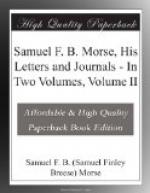“Among these latter were the celebrated Colonel Trumbull and Vanderlyn, painters of New York.... You cannot but recollect, madam, that when you yourself with your children visited it, not withstanding you expressed yourself before them in terms so strong against it and so wounding to my feelings, yet all your children dissented from you, the youngest saying it was ‘mama,’ and the eldest, ’I am sure, mother, it is very like you.’...
“Your picture, from the day I commenced it, has been the source of one of my greatest trials, and, if it has taught me in any degree patience and forbearance, I shall have abundant reason to be thankful for the affliction.”
In the end he consented to take less than had been agreed upon in order to close the incident.
As a happy contrast to this episode we have the following quotation from a letter to his wife written on February 17, 1820:—
“Did I tell you in my last that Colonel Alston insisted on giving me two hundred dollars more than I asked for the picture of little Sally, and a commission to paint her again full length next season, smaller than the last and larger than the first portrait, for which I shall receive four hundred dollars? He intimates also that I am to paint a picture annually for him. Is not he a strange man? (as people say here). I wish some more of the great fortunes in this part of the country would be as strange and encourage other artists who are men of genius and starving for want of employment.”
Morse returned to the North in the spring of 1820 and joined his mother and his wife and daughter in New Haven, where they had preceded him and where they were comfortably and agreeably settled, as will appear from the following sentence in a letter to his good friend and mentor, Henry Bromfield, of London, dated August, 1820: “You will perceive by the heading of this letter that I am in New Haven. My father and his family have left Charlestown, Massachusetts, and are settled in this place. My own family also, consisting of wife and daughter, are pleasantly settled in this delightful spot. I have built me a fine painting-room attached to my house in which I paint my large pictures in the summer, and in the winter I migrate to Charleston, South Carolina, where I have commissions sufficient to employ me for some years to come.”
He returned to Charleston in the fall of 1820 and was again compelled to go alone. He writes to his wife on December 27: “I feel the separation this time more than ever, and I felt the other day, when I saw the steamship start for New York, that I had almost a mind to return in her.”
From this sentence we learn that the slow schooner of the preceding years had been supplanted by the more rapid steamship, but that is, unfortunately, all he has to say of this great step forward in human progress.




